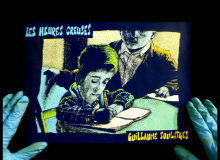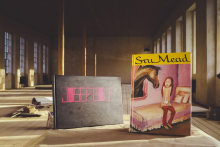| Zeitschrift Umělec 2001/2 >> Filling the Unfillable | Übersicht aller Ausgaben | ||||||||||||
|
|||||||||||||
Filling the UnfillableZeitschrift Umělec 2001/201.02.2001 Nebojša Jovanović | anarchie | en cs |
|||||||||||||
|
The theorist Renata Salecl has noticed a certain preconception whilst lecturing in the West: Western universities invariably expect her to speak primarily about events in the region she is from, meaning Eastern Europe, the former Yugoslavia or Slovenia. The list of relevant topics includes the fall of socialism, post-socialist phenomena, nationalism, and so on.1 It has become a rule of thumb that the West will welcome artists from the European East as long as they share these particular priorities. While works by Western artists are read through various systems and diverse theoretical mechanisms, an Eastern European artist is expected to place his or her work in the context of post-socialist reality. But rendering it the mere result of social and political “atrocities” often results in a brutal degradation of the work.
Certain individual artists from Bosnia-Herzegovina refuse to play this game, and are moving beyond the prejudice-filled horizon of Western expectations. They refuse to accept the role of exotic martyrs who have escaped from the bloody and dark post-socialist madhouse. Šejla Kamerić could be considered the essence of this attitude: her work strongly resists any reduction to “Eastern European,” “post-socialist,” “nationalist” or “post-war” concepts. Not only does Kamerić not revert to the topical social and political problems that characterize Bosnia today, she also refuses to subjugate her work to the imperative of a “Bosnian paradigm,” if one even exists. Analyzing her work reveals that her confrontational strategy — despite the expectations of art institutions — is inseparable from the content of her work, which systematically explores the relationship between “the subject” and Lacan’s “great Other.” In other words, she is dissecting specifically those dominant frameworks of knowledge (the ideologies) that we use to make sense of ourselves, both to ourselves and to others. Her video works Here and American Dream offer a nice beginning for the analysis of this dimension of Kamerić’s work. Although they were created separately, it is only through direct comparison — as they were originally exhibited2 — that they function as an integrated, unique piece of work. The video Here is, in fact, a clip from a program by a local Sarajevo TV station, which devotes considerable time to live broadcasts from the bustling neighborhood of Skenderija. What is remarkable is that the footage is not recorded with a TV camera, but with a surveillance camera that functions as part of the security system for the station. People walking past on the street do not suspect that they are being recorded, or observed on TV screens. Even those aware of the TV station’s “program policy” rarely remember that they are in danger of being captured by the gaze of the Other as they walk by or hurry to work through the watched area. Kamerić set this video against American Dream (AD). The video was inspired by the phenomenon of refugees in the west sending video messages back to their families and friends in their home countries. The messages offer scenes from their “new” lives and are meant to convince viewers that the recorded persons are doing well, that they have been warmly accepted into their new environment. Generally they show scenes from their new homes, neighborhoods, workplaces, their new friends and neighbors. More telling, however, are the details that promise that the senders are maintaining spiritual ties with their native countries and families. “Although we’re far away from you, we still listen to music from home, we enjoy looking through old photographs and making our food.” Kamerić is fascinated by the fundamental discord of the video messages. Though on first viewing they radiate spontaneity and authenticity, Kamerić has discovered steady delusion in them. Planned as autonomous by-products of a certain life situation, as elements of an everyday routine, the video messages turn into comical attempts to show spontaneous reality, to “act natural.”3 Fearing that their video messages will somehow fail to communicate these attributes sufficiently, the expatriates end up showing too much. Time and again they fail to imitate the spontaneity of everyday life. Thus AD, a video in which Kamerić presents the “spontaneity” of her own life in the US, but taken to the absurd, ultimately works as an imitation of imitation. How do you interpret an effect which only exists in the confrontation of two works? A standard reading of these two videos might point out that they complement each other on a formal level: Here uses a stationary camera, out of the artist’s control, while in AD she is in full control of the gaze. Here shows reality as it “is” without any intervention by the artist, while reality in AD is directed. Here shows public space, but AD presents the private domain. But what really arises from the juxtaposition of the two works can only be found by moving away from formal aspects. Let’s move closer to the center of the problem by asking the following questions: What if the point of the video messages is not to pass on messages about life in exile to family and friends? What if the issue is not the new life at all, but precisely the one the expatriates have left behind, i.e. the abandoned stabilizing reference point that is the known Other? What if the sender of the video message fears that he or she will become uninteresting and distant, unrecognizable and vague for the Other with whom he or she has, until recently, lived? That the Other will soon look at him or her just as the camera in Here looks at passers-by on the street, ignoring the subjective dimension, destroying the people as unique subjects and transforming them into an amorphous mass? But video messages also travel in the opposite direction. Family and friends who “stayed in the old life” send video messages, but with opposite sentiment: While messages from the “new life” show only novelties, messages from the “old life” show well-known faces and places. They too are afraid of being forgotten. In trying to convince the great Other that he or she still exists “in our hearts,” the senders of videos unwittingly reveal the opposite message, a need to preserve a place in the heart of the Other. The commonly held Lacanian thesis is that the great Other does not actually exist, which is banally evident in Here (looking into a camera, through which nobody is looking). Still this interpretation does not go far enough. Kamerić’s works are far from mere proof that the Other does not exist. A paraphrase of Žižek’s reference to the problems of pleasure will take us a step further. Just as the problem with pleasure is not actually that we can never achieve it, the problem with the great Other does not lie in its nonexistence but in the fact that, like pleasure, we can never escape it. We crouch forever in its shadow. It is not enough simply to see the surveillance camera as a frame behind which nobody stands. The far greater problem is that the void is never empty. The mask of the great Other (A) obscures small “others” — object (a), object — the cause of desire. If we use the metaphor of Hegel’s imperial mistake, we can say not only that there is an empire (the great Other) which is deconstructed through a small mistake (object (a) built into its fundaments, but that the smaller objects (a) survive precisely thanks to this mistake. It is out of the question for me that nobody stands behind the camera. There has to be a presence, somebody watching me. The truth is, of course, that the only thing tainting that void is my desire for a presence there. This is where AD most complements Here: It utterly reveals “A” as “a.” The entire configuration of what we expatriates have left behind crystallizes around “object (a),” the center of our desire. Making our video messages, we seek to please our illusions — views created by our desire.4 We can further investigate the implications of this travesty, this confounding of small and great, by considering Kamerić’s installation EU Citizens/Others.5 Kamerić placed signs on Tromostovlj Bridge in Ljubljana, Slovenia, which divided people into “EU citizens” and “Others” at the regulatory border crossing. Standing on Tromostovlj Bridge you could choose whether you wanted to cross under the “EU Citizens” sign or under “Others.” But no matter how careful your choice, you would be cheated in the end anyway: Turning around after crossing under the signs, you discovered that the backs of the signs read the opposite from the fronts. Shallow criticism of this work commented on its topical political context, mired in the thesis that it reflects the frustrations of countries waiting to enter the EU. That it reminds them of how close they are to the EU while still so far away. That the decision on who becomes an EU member and who doesn’t is not up to the individual states but up to the member states of the Union. But the problem is a far more common one. Far from linking into a political context, the great Other regularly fails us by sending our own message back to us in its reversed, true meaning: “I want to enter the EU!” – “Oh, no, what you really want is your little nation state because the EU is not actually a consensual project.” Or: “I want to be with the others!” – “Aha! You are showing your hatred of the EU and you are in fact more European than Europeans themselves. If you somehow found yourself on the other, the EU side, you would introduce even harsher segregation policies than the existing ones.” If we really had a choice, did we decide to remain tied to the national state? Couldn’t somebody choose, for example, the EU option because he or she feels like being a member of European civilization, the cultural and geographical area, and thus completely ignore the issue of a national state? The answer might be found by demystifying the fashionable dogma around the notion of a free choice of identity. According to this dogma, a subject freely and rationally chooses from and combines the various identities that come displayed on the shelves of the supermarket of postmodernism. But the dogma covers up the fact that the subject cannot break away from the object. We are free to choose a hatful of identities, but not without accepting and maintaining the set framework. For instance, it is an accepted truism that under the liberal democratic system we can choose from various political options, but at the price of conceding that capitalism is “the only game in town.” In cyberspace we can be whoever we want, so long as we consent to the interface that separates us forever from our symbolic replacement. We can also describe this logic using a number of political phenomena still topical in Kamerić’s region. The election system in Bosnia-Herzegovina provides one example: When you cast your vote for the candidates for the three-member presidency, you choose from among the Social Democrats, Liberals, Nationalists, Republicans and so on. But ultimately all three candidates end up trapped in the three-nation matrix of the state Presidency. Despite the fact that you vote for, say, a Social Democratic candidate “in full consciousness,” he or she will end up being a representative of one of the three Bosnian nations, reduced to being either Bosnian, Serb or Croatian. We can now use the psychoanalytical model of guilt. Guilt felt for a single committed crime replaces the guilt of the original crime of patricide, which original guilt draws away from the father’s impotency, which would have rendered it unnecessary to have killed him in the first place. Analogously, boasting that we have chosen an identity that we desire covers up the fallaciousness of the selection, just as would be the case within any other framework. The fact that we cannot escape the framework then dissimulates the existence of the great Other, powerful enough to create or destroy this framework. Therefore, due to its very framework, the choice EU Citizens vs. Others reveals all the naivete inherent in the issue of national states. You walk under the “EU Citizens” or the “Others” sign but the national state within or outside arbitrary European borders does not cease to exist. But more than that, you have to assume responsibility for your choice — there is no avoiding it: “Oh, I didn’t know what it was about. To me, Europe is Cervantes, Kierkegaard, Musil, Buńuel … It is not a question of the national state…” Kamerić has elevated to a state of absurdity in some of her works the insistence on the power of the great Other and its constant intrusiveness. In her intervention Crossroad,6 she placed (this being her favorite artistic act) a zebra crossing on an almost deserted roadway. You find yourself in the middle of nowhere and the great Other demands you cross the road at the designated spot. Would you comply?7 Kamerić identified an even more extreme case of the interjection of the subject in the November 2000 election campaign in Bosnia-Herzegovina. In a campaign of propogandist muck slinging by all parties, now considered the most brutal in recent political history in Bosnia-Herzegovina, the HDZ BiH made the most radical pre-election move by declaring a referendum for Croatian citizens in Bosnia-Herzegovina to take place on the day of election. HDZ then put up a billboard, divided through the middle. The upper white part said “Choice,” meaning the choice of the nationality you profess to be. The bottom black part said “Extermination,” and the center of the billboard read “Or.” On the level of manifestation, the billboard allows the viewer the options of “Choice,” voting for rights that would ultimately allow the formation of parastatal bodies and the third ethnically determined entity, or “Extermination.” Croatians will be exterminated by the Bosnians, Bosnian Muslims and Serbians. At this point Kamerić decided to highlight the ideological presumption of this message by recreating it. In her work, Exter-mination,8 she copied the black part “Extermination” and pasted it over the upper part of the billboard, transforming the message into a message saying: “Extermi-nation Or Extermination.” Either we, Bosnian Croats, exterminate other nations or we will be exterminated ourselves.9 Occupying a vacant place, filling the void, is one of Kamerić’s main themes. In her installation Occupied,10 she stretched a sign reading “Occupied!” in red letters on white canvas over the facade of the Art Gallery in Bosnia-Herzegovina. Shallow criticism identified this as the rebellious attitude of a young artist who wanted to provoke the prototypical art institution of Bosnia-Herzegovina, filled as it is with labels like tradition, establishment and so on, by saying that she was going to lay claim to it. Far from juvenile extravagance, Kamerić offered a much more subversive attitude. “Despite the fact that the existing art establishment — embodied by the National Gallery — may label me as ‘young,’ ‘woman,’ ‘unestablished’ and so on, I have the right to look for my place in the National Gallery!” This attitude is far more radical and Lacan can help us in summarizing: “The gallery does not exist!” In fact, it only exists as a temporary appropriation by a curator or an artist.11 So isn’t a gallery just a cash register like the one in the photograph Kamerić took and exhibited as one of her first works?12 A till as a paradigmatic object whose only function is to be occupied, filled? It is the gallery that has the ability to prove the thesis that the “great Other does not exist” outside the subject. A young artist wishes her work to be inscribed in the register of the great Other, to be recognized by the art scene and the general public. The standard procedure would be to exhibit her work in a gallery. But Kamerić realized that the very entrance of a work of art into a gallery radically changes the framework of the gallery (the great Other). And if a single work of hers enters a gallery, the artist will never be the same, as each new occupation irrecoverably changes her and vice versa.13 Let’s go back to the original question of how the two videos, Here and AD, complement each other. If we assume that Here is asking how one can be recognized in a crowd in order to subjectivize oneself in a world watched by the ruthless eye of the great Other, AD provides a cruelly false answer, a comical impasse in its distilled form. AD thus works as a Hegelian detour through incorrect cognition, as a trajectory we are to step over to get the true answer to our question. Does the surveillance camera film the crowd, which ultimately is not its real function, in order to single out an individual as unique and original? That is why, paradoxically, the boring monotonous images of public space recorded by the surveillance camera actually deliver the subject in its uniqueness, while video messages that attempt to do the same ultimately miss their target. Which brings us to the conclusion that Here is in fact the only video message that meets the condition of the subjectivity of the expatriates in the eyes of their families and friends. Video messages made by surveillance cameras in shopping centers, office buildings and parking lots should be sent home from the Diaspora instead. Films that show the expatriates getting around, shopping, and working. Only then would their friends and relatives have to “pull” them out of the recorded crowd and assign them their status as a subject through re-recognition. Photographs courtesy of Šejla Kamerić
01.02.2001
Empfohlene Artikel
|
|||||||||||||
|
04.02.2020 10:17
Letošní 50. ročník Art Basel přilákal celkem 93 000 návštěvníků a sběratelů z 80 zemí světa. 290 prémiových galerií představilo umělecká díla od počátku 20. století až po současnost. Hlavní sektor přehlídky, tradičně v prvním patře výstavního prostoru, představil 232 předních galerií z celého světa nabízející umění nejvyšší kvality. Veletrh ukázal vzestupný trend prodeje prostřednictvím galerií jak soukromým sbírkám, tak i institucím. Kromě hlavního veletrhu stály za návštěvu i ty přidružené: Volta, Liste a Photo Basel, k tomu doprovodné programy a výstavy v místních institucích, které kvalitou daleko přesahují hranice města tj. Kunsthalle Basel, Kunstmuseum, Tinguely muzeum nebo Fondation Beyeler.
|


































 We Are Rising National Gallery For You! Go to Kyjov by Krásná Lípa no.37.
We Are Rising National Gallery For You! Go to Kyjov by Krásná Lípa no.37.
Kommentar
Der Artikel ist bisher nicht kommentiert wordenNeuen Kommentar einfügen